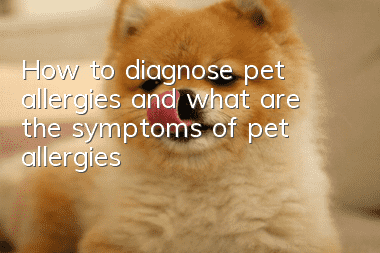How to diagnose pet allergies and what are the symptoms of pet allergies?

There is no doubt that there are many benefits to keeping pets. According to research, owning a pet can even improve the prognosis of patients with cardiovascular disease. However, allergies to pets are common, especially for those with allergic diseases or asthma. In the United States, 3 out of 10 allergy sufferers are allergic to cats and dogs. People who are allergic to cats are twice as likely to be allergic to dogs.
1. Are there any hypoallergenic pets?
Some people who are allergic to dogs may be more allergic to certain types of dogs, while others are allergic to all dogs. But in fact, there is no such thing as a truly non-allergic dog or cat.
2. How do pet allergies occur?
The important function of the human immune system is to fight against and eliminate exogenous harmful substances, such as viruses and bacteria. Normally, this response protects the body from disease. People with pet allergies have overly sensitive immune systems. Their immune systems also react to harmless proteins found in your pet's urine, saliva or dander (dead skin cells). This symptom is an allergic reaction. Substances that can cause allergic reactions are called allergens.
Pet allergens can be deposited on furniture and other surfaces. These allergens do not lose their allergenicity over a long period of time. Sometimes, these allergens can remain on walls, furniture, clothing, and other surfaces for months.
Pet hair is not an allergen, but it can collect dander, urine and saliva, and can also carry other types of allergens such as mites and pollen.
Cat and dog allergens are everywhere. Pet allergens can even be found in homes and other places where pets have never been kept. This is because people can carry pet allergens through their clothing. Additionally, pet allergens can be airborne and may be dispersed during cleaning, dusting, or other activities. Once pet allergens are dispersed, they can remain suspended in the air for a long time.
3. What are the symptoms of pet allergies?
Cat and dog allergens can settle on the surface of the eyes and nasal cavity, causing symptoms such as nasal itching, nasal congestion, itchy eyes and watery eyes. Scratching or licking by pets can cause skin redness. It is very common for your pet to get itchy eyes after petting them.
If the allergen level is very low or the sensitivity is mild, symptoms may not appear until many days after exposure to the pet.
Many fine particles in the air are small enough to enter the human lungs. Sometimes, this exposure can cause severe respiratory symptoms. Highly sensitive people may develop coughing, wheezing and difficulty breathing 15-30 minutes after inhaling allergens. Sometimes acute urticaria may occur on the face, neck, and upper chest.measles.
3 out of 10 asthma patients will have an acute asthma attack after contact with cats. Cat allergens can also cause chronic asthma.
4. How to diagnose pet allergies?
Doctors make a diagnosis of pet allergy based on your symptoms, signs, medical history, and test results. Usually, serum allergen-specific IgE and allergen skin tests are needed to help determine the type of allergen.
Some people find it hard to believe that they are allergic to their pets. Your doctor may tell you to stay away from your pet for a while to see if your symptoms subside. However, pet allergens can still trigger symptoms months after the pet has been gone because pet allergens are often difficult to remove.
5. How to treat pet allergies?
The best treatment is to avoid contact with the cat or dog's living environment. No pets allowed in the home. If possible, try to avoid visiting places where pets with allergies are present. Strict avoidance of cats and dogs can relieve your symptoms so well that medication is no longer needed.
Keeping pets outdoors can improve the condition to some extent, but it cannot completely eliminate allergens in the home. Another possible option is to choose a pet without fur or feathers. For example, fish, snake or turtle are all options.
Pet allergies are sometimes a social problem, making it difficult for sufferers to visit friends who have cats and dogs (as well as horses and other animals) at home. Children, especially, cannot attend gatherings at friends' homes. However, you can seek help from an allergist and take some medications before going to these places to prevent symptoms from occurring. Anti-allergic drugs; nasal sprays, inhaled corticosteroids and other drugs can usually be chosen for prevention.
6. What should I do if I want to keep my pet?
Sending the pet away is the best treatment. However, if you still want to keep your pet, there are steps you can take to reduce exposure.
Keep pets out of the bedroom. Keep bedroom doors closed as much as possible to keep pets out, and clean aggressively. Consider using an air purifier with a HEPA filter.
Animal allergens are sticky. Therefore, you have to remove the animals' favorite furniture such as carpets, scrub walls and wooden furniture. Keep furniture surfaces in your home clean and tidy. Keep floors and walls uncovered.
If you absolutely want carpet, choose a thinner type and clean it frequently. It is best to use one that is easy to wash and use hot water.
Wear a mask when using a vacuum cleaner. Vacuum cleaners can aggravate symptoms by kicking up allergens stuck in the carpet.
When wearing clothes that are exposed to pets for a long time, change clothes frequently.
Heating the room and using air conditioning can speed up the spread of allergens in the room, which requires attention.
Using an air purifier with a HEPA filter can help remove pet allergens from the air in your room. Use it for at least 4 hours a day. But air purifiers cannot remove allergens that stick to surfaces.
Weekly bathing of pets can reduce levels of allergens in the air, but its value in reducing allergy symptoms is unclear.
Ask someone who is not allergic to brush your pet and clean its box or cage.
Discuss the use of medications and consider specific immunotherapy (desensitization therapy) with your allergist.
Summary
We have found in clinical practice that some allergic patients are mostly allergic to mites in the early stage, but after adopting a pet, they develop pet dander allergy. The shortest time is half a year, and the longest time is 8 years before pet allergy appears. Moreover, after pet allergy occurs, the symptoms become more serious, such as asthma symptoms, and the onset is often acute. Allergens in allergic patients will change (progress) over time, and the body will develop an immune response to "substances" that it has not been exposed to earlier, leading to allergies. Therefore, we recommend that people with allergies should not keep pets at home. If a pet allergy appears, it is recommended to get out of the allergic environment as soon as possible, clean the room thoroughly to remove allergens, and give the pet to others. In addition, medications are used to control symptoms. If you want to keep your pet, you need to follow the steps in this article to ban pets from the bedroom, use an air purifier, and perform pet allergen desensitization treatment if necessary.
This article is compiled from a blog article by the American Allergy and Asthma Association (AAFA, Asthma and Allergy Foundation of America). The pictures in this article come from the Internet, and I pay tribute to the original author of the beautiful photos!
- What are the symptoms of a tiny, hopeless dog?
- Things to note when raising a Chow Chow
- If your dog bites things randomly, correct the cause!
- How to trim your dog’s toenails
- What are the Springer training techniques?
- What should I do if my dog gets carsick? Let’s learn how to train your dog not to get carsick!
- How to train a beagle, intensive training methods for a beagle!
- The harm of disinfectants to dogs, poop scavengers need to pay attention!
- How to improve dogs’ gastrointestinal problems
- How to treat parvovirus in Central Asian Shepherd Dogs



